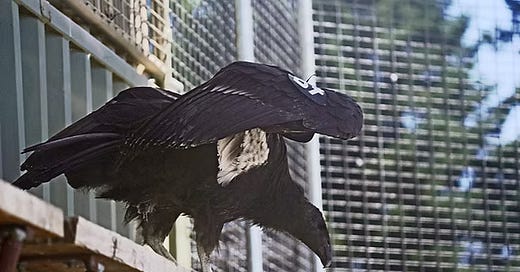Preventable Death Rattles Yurok Tribe’s Pioneering Condor Program
Partnering with the feds, the tribe has led the way on restoring the pre-conquest wild to Redwood National Park’s skies.
Back in January came a disturbing discovery in a remote corner of the park: the carcass of a California condor that had been released into the wild only three months earlier. The death signaled the first significant setback for a groundbreaking, tribally led effort to bring North America’s largest bird back to its ancestral range along California’s North Coast.
Condors have been extinct in the region since the 1890s, destroyed by settlers who shot them down or poisoned them with arsenic- and strychnine-laced carcasses intended to destroy wolves and bears. And as the settlers killed off 75 percent of the Yuroks and took over their lands, they prohibited the tribe’s stewardship practices, like cultural burns to maintain the prairies that sustain the deer and elk condors scavenge.
To the Yuroks, who are California’s largest federally acknowledged tribe, the eradication of the condor stands as a spiritual catastrophe. The great bird — prey-go-neesh in the Yurok tongue — has been woven into the Hlkelonah, the Yuroks’ cultural and ecological landscape, since the world began. Condors play important roles in the tribe’s creation stories, and condor feathers and songs are significant components in Yurok world renewal ceremonies.
Condor restoration was the tribe’s idea, one that required it to build a then-unprecedented partnership with the National Park Service and the U. S. Fish and Wildlife Service. The work began in 2003 with an elders council’s vision to restore the sacred birds to the tribal homeland’s skies and a commitment to do what it would take to make the vision real. From that beginning the Yurok Tribe Wildlife Department did the hard work of assessing the habitat the reintroduced condors would occupy and learning the intricacies of caring for birds whose lifestyles are both solitary and communal.
Since the condors would range well beyond Yurok country, community meetings were held as far north as Portland, Oregon, and as far south as Sacramento, California. Once attendees were assured that condors posed no danger to them or their dogs, cats, and backyard chickens, popular response to the idea of bringing back the majestic creatures grew enthusiastic. Buoyed by public acceptance of the program, the Yurok Tribe concluded a memorandum of understanding with 16 public and private entities ranging from NPS and the Bureau of Land Management to Pacific Gas and Electric and the Ventana Wildlife Society. After fourteen years of work, including a five-year National Environmental Protection Act review process that involved the tribe as an equal and sovereign partner with NPS and Fish and Wildlife, the Yuroks received approval to bring the long-missing birds home.
The tribe built a release facility and other infrastructure in a remote location within Redwood National Park. The first bird to arrive was Condor 746, an eight-year-old adult male nicknamed Paaytoquin (Come Back) and borrowed from an Idaho breeding program to mentor the younger birds being prepared for release. Paaytoquin did his job of teaching life lessons well, and in 2022 eight birds — each carrying an identifying number and a Yurok name capturing that condor’s personality — were released, tracked, and monitored. Following the Northern California Condor Restoration Program’s plan for annual releases of four to six birds annually, the total number of birds returned to the wild by the end of 2024 had reached 18, without a single loss. Then came the death of Pey-noh-pey-o-wok’ (I Am Friend).
Lead poisoning from a swallowed airgun pellet was the culprit, evidence yet again that human neglect poses the biggest risk to condors. How exactly Pey-noh-pey-o-wok’ got that fatal dose of lead is uncertain, but it likely came from eating game that was shot and either lost or discarded. Condors are scavengers, after all, and the Northern California Condor Restoration Program has gone to great pains to find lead-laced carcasses before the condors do. In late 2022, for example, two poached elk containing enough bullet fragments to kill several birds were discovered and removed before the condors dove into a fatal feast. Pey-noh-pey-o-wok’ wasn’t so lucky.
All lead ammunition has been banned for hunting in California since 2019 because of the risk it poses to apex scavengers. Sportsmen who say lead is superior and cheaper than copper — it is neither — simply buy out of state then lock and load. Pey-noh-pey-o-wok’ was likely the victim of outdoorsy scofflaws who gave not a damn about the consequences.
In a Yurok Tribe press release about the death of Pey-noh-pey-o-wok’, Tiana Williams-Claussen, the Harvard-educated director of the Yurok Tribe Wildlife Department who has led the Northern California Condor Restoration Program from its beginning, said, “Pey-noh-pey-o-wok’ was known for his friendliness, preening and huddling together with other condors, sharing food easily. He had only been flying free for a few months. That he was brought down by something human-caused and preventable is devastating.”

While researching Cast out of Eden, I interviewed Williams-Claussen, who made clear the long-term stake she and the tribe have in bringing condors back.
I have a four-year-old daughter. She is going to grow up with condors in her sky for her entire life. She is not going to know what it is to miss condors. She will always live in relationship with condors, which is really what this project is all about — bringing condor home, back into our communities, back into our conversations, back into our households, and into the minds and hearts of our children on behalf of the hearts of our elders.
Up next: What’s sacred got to do with it? Short answer: Everything.
More about the Yurok condors
The tribe’s website offers a trove of information about the great birds, as well as a live-feed condor cam. Well worth checking out.





